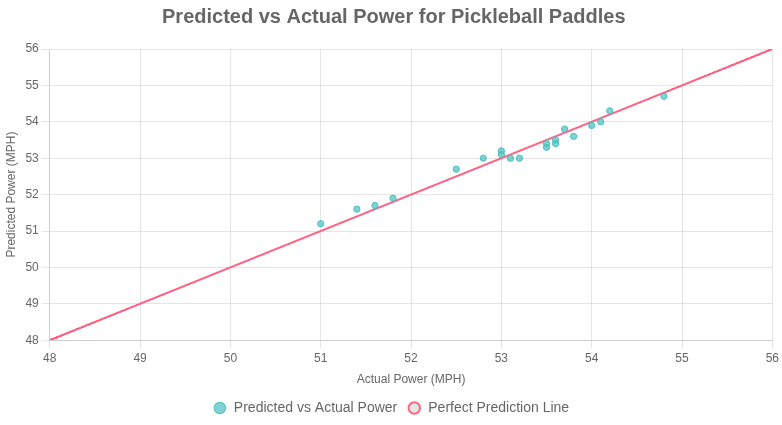
Accurate Calculation of PBCOR from Core Features with ML
|
|
|
Time to read 3 min
|
|
|
Time to read 3 min
Derivation of the Paddle Performance Calculator Logic
Date: July 15, 2025
To develop a reliable, data-driven calculator to predict a pickleball paddle's Coefficient of Restitution (PBCOR) based on its physical design parameters. This tool is intended to aid in the research and development process by providing performance estimates without requiring constant, expensive lab testing.
The foundation of this project was empirical data sourced from the "PPL Paddle Performance Trends" PDF document. Key performance metrics were manually extracted from the bar charts on pages 3 ("Traditional Paddle PBCOR vs ADF, Thickness and MOI") and 5 ("Foam Core Paddles").
This process yielded a structured dataset with 15 distinct data points, each containing the following features:
An iterative modeling process was undertaken using multiple linear regression to determine the relationship between the physical features and the resulting PBCOR.
Initial attempts to predict PBCOR using only MOI and Thickness proved highly ineffective. A model incorporating these two features, along with a combined "interaction" feature (MOI * Thickness), could only explain about 13.4% of the variance in the performance data (R-squared ≈ 0.134). This confirmed the PDF's claim that these features are not primary performance drivers on their own.

A new model was developed that included ADF (stiffness) alongside MOI and Thickness. The inclusion of this single variable dramatically improved the model's predictive power. The final, most accurate predictive formula was determined to be:
The R-squared value for this model was 0.825, indicating that this formula can explain approximately 82.5% of the performance variation in the dataset. This confirmed that a paddle's stiffness is the most critical factor in determining its coefficient of restitution.

A significant practical challenge is that ADF is a lab-measured value, making it difficult to use in a day-to-day design environment. To overcome this, a method was derived to calculate ADF using a simple, in-house physical test. The derivation is based on the physical principle of stiffness (Stiffness = Force / Deflection) and the known parameters of the official USAP test protocol:
d) of a paddle in inches under the 5 lb load.Using these knowns, the formula to convert a measured deflection (d) into an ADF value was derived:
The final calculator logic combines the predictive model with the practical ADF proxy. This creates a two-step process that allows a designer at Coretek to estimate a paddle's performance using a simple physical measurement.
d) in inches.ADF = 0.3125 / d.ADF, along with the known MOI and Thickness of the paddle, into the final predictive formula.This systematic process of data extraction, iterative statistical modeling, and logical derivation has produced a robust and scientifically-grounded calculator. By leveraging a simplified physical test to create a proxy for the most critical performance variable (ADF) we can simulate PBCOR based on a known feature.
Tool